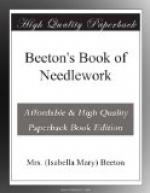[Illustration: 108—Rose in Satin Stitch.]
[Illustration: 109.—Petal for Rose.]
ILLUSTRATIONS 108 & 109 (Rose in Satin Stitch).—No. 109 shows one petal larger than full size. The outer circle only is prepared with chain stitches underneath, so as to appear raised; the inner circles are worked flat. The centre of the rose is embroidered in open work.
[Illustration: 110.—Heartsease.]
ILLUSTRATION 110 (Embroidered Heartsease).—For
the knotted stitch see
No. 75. for the point croise see 71 and 72.
[Illustration: 111.—Raised Flower]
ILLUSTRATION 111 (Flower in Raised Satin Stitch).
[Illustration: 112.—Ear of Corn.]
ILLUSTRATION 112 (An Ear of Corn in Point de Minute).
[Illustration: 113.—Bluebell.]
[Illustration: 114.—Inner part of Bluebell.]
ILLUSTRATIONS 113, 114, & 116 (Bluebell in Raised Satin Stitch).—This flower is worked partly in separate pieces, as has been described. Illustration 116 shows the raised part stretched out flat. When it is finished it is fastened down along the dotted line on No. 114, which shows the inner part of the flower.
[Illustration: 115.—Flower.]
ILLUSTRATION 115 (Flower in Point de Minute).—This stitch is here worked over a thick foundation of chain stitches. For raised patterns it looks very well.
[Illustration: 115.—Outer part of Bluebell.]
[Illustration: 117.—Flower appliqued on Net.]
ILLUSTRATIONS 116 & 117 (Flower worked in Applique).—To work in applique, two materials, either similar or different, are needed. You can work either in applique of muslin on muslin, or of muslin on net, or of net on net. Muslin on Brussels net is the prettiest way of working in applique; we will therefore describe it: the other materials are worked in the same manner. Trace the pattern on the muslin, fasten the latter on the net, and trace the outlines of the pattern with very small stitches work them in overcast stitch with very fine cotton, taking care not to pucker the material. The veinings are worked in overcast. When the pattern has been embroidered cut away the muslin round the outlines with sharp scissors, so that the net forms the grounding (see No. 117). The greatest care is required in cutting out the muslin to avoid touching the threads of the net.
[Illustration: 118.—Border.]
ILLUSTRATIONS 118 & 119 (Narrow Borders).—It will be easy to work these borders from the above instructions. Observe only that on border 118 the outer row of scallops is worked first, then the button-hole stitch row, and the rest afterwards. The spots are edged all round in knotted stitch. The wheels in the centre of the eyelets of No. 119 are worked with very fine cotton in loose button-hole stitch; they are wound round with the cotton in a second row.




